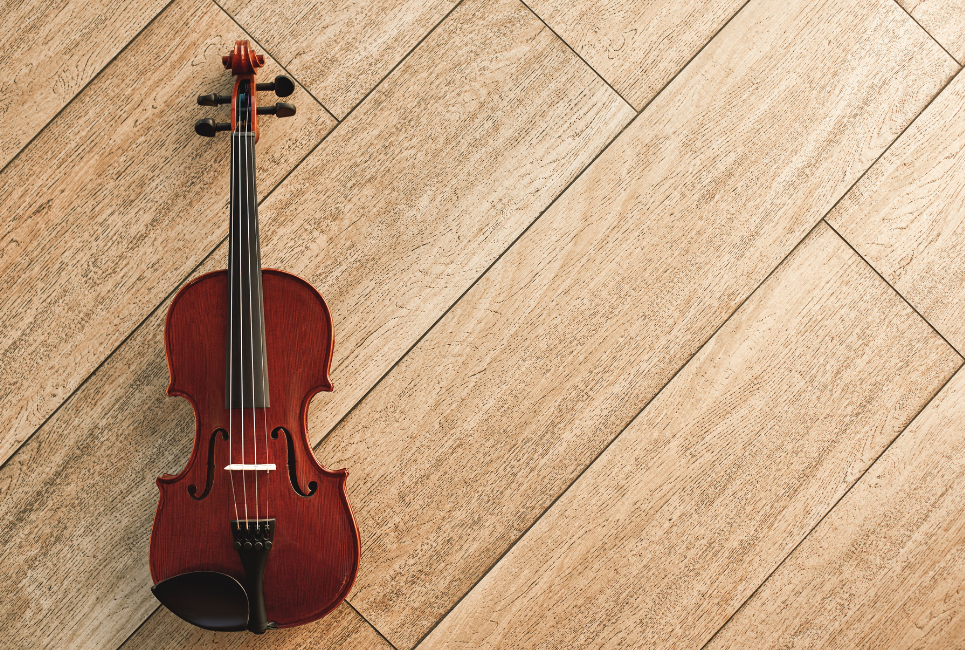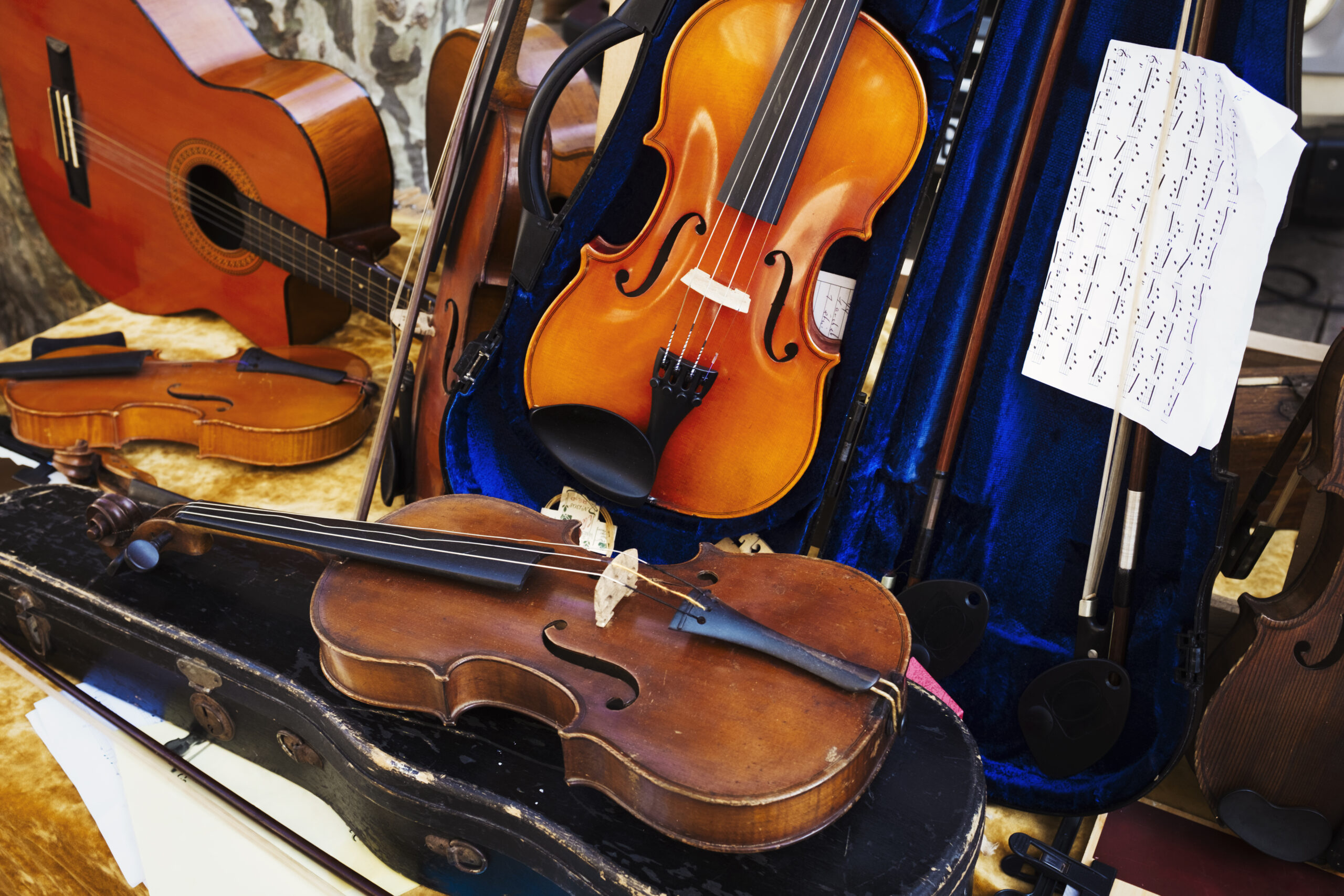- Best Fretted Violins Guide - May 31, 2022
- Best Yamaha Violins Brand Guide - April 13, 2022
- An Honest Mendini MV300 Review - March 31, 2022
If you’re reading this article, it means that you have started the search for a 1/32 violin – the tiniest violin there is! It is never too early to begin considering music lessons for a child. Some of the most successful violinists started when they were very young. These are for the smallest of violinists, usually around two years old. If you can’t imagine your two-year-olds sitting down and playing the violin, that’s okay; not many students, even prodigies, start out this young. Many violinists start out on 1/8th when they start school, but some may start out with smaller ones like 1/10th or 1/16th.
If you have a kiddo with an affinity for the violin at such a young age, don’t worry, I’ve got all the info you need about tiny violins.
Bottomline
1/32 violins are usually rented instead of bought because they aren’t worth buying for such a short amount of use, typically not excellent quality. However, there are a few affordable options on the market if you really want one of these mini violins.
My top pick is the Cecilio MV300 for its excellent affordability to quality ratio.
Violin Sizes & Measurement
Violins come in eight sizes, and finding the right size can be done in a few ways. The easiest is to have your child hold the violin as if they would play and wrap their hand around the scroll. If they can do this comfortably, the violin is the right size. If they can’t reach the end, the violin is too small, and if they have a lot of leftover space, the violin is too big. A more precise way to find the right size is to measure your arm from the neck to the palm of your left hand. The measurements for each size are as follows:
- 4/4 – 23 inches or more
- 7/8 – 22 to 23 inches
- 3/4 – 21.5 inches to 22 inches
- 1/2 – 20 inches
- 1/4 – 18 to 18.5 inches
- 1/8 – 16.5 inches
- 1/10 – 15 inches
- 1/16 – 14 inches
- 1/32 – under 14 inches
All professional violinists use full 4/4 sizes, except for shorter violinists who prefer a 7/8 size.
Presumably, if you’re reading this article, then you’re looking to buy a 1/32 size violin for a small child, not yourself. Suppose your child is so tiny that they need a 1/32 size violin. In that case, it’s important to remember that they will need to trade-in or get a new violin roughly every year or two as they grow.
Why get a 1/32 size?
1/32 Violins are indeed a bit odd, and they certainly don’t sound all that great. They provide a small child with just enough to learn posture, hold the bow, and play their first notes and scales. A small child may work their way through a small portion of the first Suzuki method book on one of these, but they won’t progress until they are older. Within the first two years, you will already be looking to upgrade the violin to its older sibling, the 1/16th. I personally don’t know many toddlers who would ask for a violin unless they were from a family of musicians. If your toddler asks for a violin, I will convince them to wait until they are old enough for a 1/6th violin.
There are many reasons for this; the biggest is that it’s just not worth purchasing this tiny violin. It won’t be worth trading in, and at best, it’s a sentimental piece. The second is that at 2 or 3 years old, a child’s hand and eye coordination is still doing some significant development. Some may have been walking for less than a year. They also lack an attention span when taking lessons and learning. Instead, bolster their thirst for knowledge by showing them videos of professional violinists and kids a year or two older. This will keep them excited and engaged; if their attention wanes or they no longer want a violin before they are old enough for a 1/16th, you’ll know it wasn’t meant to be.
If you are a musician, have a persistent child, or just really want to give your kid this experience early on then, have no fear, I have options!
Finding a 1/32 Violin
There are many ways to acquire a 1/32 violin. The first is deciding whether to rent or buy this tiny violin. These violins aren’t worth anything. These are so small and used for such a short amount of time that they don’t have any quality or effort. No tonewoods, string changes, or fittings could make these sound as good as their bigger counterparts. Paganini was just not meant to be played on such a tiny instrument.
In many ways, this considerably helps the buying choice. The cheapest 1/32th violin will not be noticeably different than the most expensive. Get what will work for now at the lowest price point or rent!
There are many places to rent violins; your preferred retailer is probably through your local music shop if you have one. If you don’t, a few places rent these violins online, and some ship worldwide! When renting a violin, make sure the contract specifies that you can trade it in for bigger sized instrument at any time for no cost and that a portion of your rent payments each month is put towards the purchase of a violin when your kid reaches full size or needs an intermediate instrument.
Renting will ensure that you don’t spend too much money upfront if your child does not like the violin; it also saves you the hassle of trading in or selling smaller violins.
Many music stores will partner with specific student violin brands, rent their own violin brand, or simply use trade-ins as rental instruments. These instruments are inspected and set up perfect for a new student. They also come with various accessories and add ons so your kiddo has everything they need to get started.
Shar Music is a well-known musical instrument rental service for the United States. They have rentals ranging from 1/32 to full size and student to professional levels.
The 1/32 Violins I’d Buy
If you are set on purchasing a 1/32 violin, don’t worry; I’ve rounded a few that are sure to please. Honestly, I kind of want one of these tiny violins, if anything, as a fun toy to bring out at parties or annoy my loved ones with. These tiny violins are also great art canvases if you are so inclined, a versatile instrument all around. These violins were chosen mainly due to availability, price, brand reputation, and overall reviews.
Top Pick
Mendini by Cecilio is well known for making student-level violins in various price ranges and quality levels. I wasn’t surprised to find that they offer a 1/32 violin, but I was a little surprised that it’s their slightly upgraded model, the MV300. Not that it really matters in terms of tone or quality. Still, while tiny, this violin features the same specs as its full-sized version with a solid carved spruce top, maple back and sides, and an ebony fingerboard. It’s an excellent tiny violin. Most importantly, it’s incredibly cheap, currently priced under 80 dollars, so it won’t break the bank. It can be a sentimental piece as your child grows.
Pros
- Inexpensive
- Made with quality material
- Comes with all of the basics
- Surprisingly high quality for the price
Cons
- Cecilio bows are known to be poor quality
- The strings are terrible, but it hardly matters
Cremona SV-100 Premier
Cremona makes a variety of student to professional-level violins. One of their cheapest violins, the SV-100, is offered in 1/32 size for an affordable price. Its made with spruce and maple tonewoods, fitted with rosewood fittings, and has either ebony or maple fingerboard. This violin gets some bonus points for me due to the rosewood fittings, as those are my favorite, but the varnish is far too yellow for my liking. Otherwise, this violin is pretty standard but more than I would pay for a tiny violin. Suppose you have multiple small violinists who will use this instrument. In that case, purchasing a slightly higher quality violin from Cremona will help with the instrument’s overall durability and longevity.
Pros
- Quality tonewoods
- Set up with Prelude strings, a standard student steel string
- Comes with a basic case and bow to get you started
- Rosewood fittings look really nice
Cons
- Considerably more expensive than the MV300
D’Luca CAD01 Violin
The D’Luca CAD01 is very similar to the MV300. It features solid spruce and maple tonewoods and an ebony fingerboard and fittings. The outfit includes a case, bow, rosin, and tuner. Despite being similar to the MV300 in both specs and looks, it is considerably more expensive. While I doubt that the tonewoods used for this violin are of better quality, it’s just not an important feature for a tiny violin. Still, this violin is an option to spend some extra money. I’d still recommend the MV300 because it’s over 100 dollars cheaper.
Pros
- Quality tonewoods and material
- Comes with everything you need to get started
Cons
- Very similar to the MV300, which is half the price
- Not worth its price tag for the short amount of time used
Here are some FAQs:
Answer: A 1/32 size violin is around 13 inches or 33 centimeters. A 1/32 size violin will come with a bow about 15 inches or 38 centimeters.
Answer: A 1/16 size violin is a standard starting violin for young students around 3 to 5. These violins are just a little bigger than their smaller sibling and sound similar in an empty, squeaky tone.
Answer: Most 1/32 violin outfits come with all of the basics you need outside of maybe a method book. The strings, bow, shoulder sponge, and rosin will be basic enough to get your student to the next size. Most people don’t start purchasing specific accessories until they are in larger sizes like the 3/4th or full size. Please see: Best Beginner Violin: How To Choose the Right One?
Answer: If your child is playing a 1/32 size violin, they are very young and at the start of their journey with music. It is vitally important that they develop good habits and posture at the beginning. Bad posture and habits can hinder your player’s progress or even injure them. Starting the violin is hard enough in itself, but creating a small child on the violin is nearly impossible if you do not have the proper technique. For these reasons, it is strongly recommended that you find a teacher when your student first expresses interest in the violin. This will help you understand what they look for in such a tiny violin.
Final Thoughts
You should congratulate yourself on encouraging to start your child to play at a very young age! Remember that playing the violin is one of the hardest things to do. Never be harsh on your child for not sounding good or not practicing enough; that will just ruin their spirit and not encourage them to continue playing. Your job as a parent is first and foremost to cultivate a love for music and the instrument, and if they have that, they will be very successful.
Once your child is starting to look at larger-sized instruments, please take a look at: Best Beginner Violin: How To Choose the Right One?




